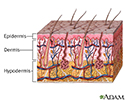Cherry angioma
Angioma - cherry; Senile angioma; Campbell de Morgan spots; de Morgan spots
A cherry angioma is a noncancerous (benign) skin growth made up of blood vessels.
Causes
Cherry angiomas are fairly common skin growths that vary in size. They can occur almost anywhere on the body, but usually develop on the trunk.
They are most common after age 30. The cause is unknown, but they tend to be inherited (genetic).
Symptoms
A cherry angioma is:
- Bright cherry-red
- Small -- pinhead size to about one quarter inch (0.5 centimeter) in diameter
- Smooth, or can stick out from the skin
Exams and Tests
Your health care provider will look at the growth on your skin to diagnose a cherry angioma. No further tests are usually necessary. Sometimes a skin biopsy is used to confirm the diagnosis.
Treatment
Cherry angiomas usually do not need to be treated. If they affect your appearance or bleed often, they may be removed by:
- Burning (electrosurgery or cautery)
- Freezing (cryotherapy)
- Laser
- Shave excision
Outlook (Prognosis)
Cherry angiomas are noncancerous. They usually do not harm your health. Removal usually does not cause scarring.
Possible Complications
A cherry angioma may cause:
- Bleeding if it is injured
- Changes in appearance
- Emotional distress
When to Contact a Medical Professional
Contact your provider if:
- You have symptoms of a cherry angioma and you would like to have it removed
- The appearance of a cherry angioma (or any skin lesion) changes
References
Dinulos JGH. Vascular tumors and malformations. In: Dinulos JGH, ed. Clinical Dermatology. 7th ed. Philadelphia, PA: Elsevier; 2021:chap 23.
Patterson JW. Vascular tumors. In: Patterson JW, ed. Weedon's Skin Pathology. 5th ed. Philadelphia, PA: Elsevier; 2021:chap 39.
Review Date: 11/30/2022
Reviewed By: Ramin Fathi, MD, FAAD, Director, Phoenix Surgical Dermatology Group, Phoenix, AZ. Also reviewed by David C. Dugdale, MD, Medical Director, Brenda Conaway, Editorial Director, and the A.D.A.M. Editorial team.



